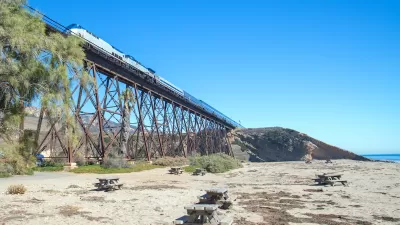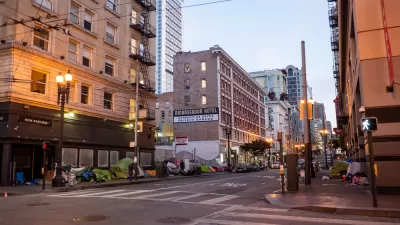“[There] is something about the frequency with which California and 'the future' are used synonymously,’ writes Kristin Miller. But the future looks much different when set in Southern California as compared to Northern California.
Does this story line sound familiar? “10 to 150 years from the present, California has succumbed to natural disaster/economic and governmental collapse/a pandemic, which leaves Southern California a corporate-fascist-military state with gross financial and racial inequality and urban squalor—while Northern California rips up its pavement, learns permaculture, gets spiritual, and models better living through technology and communitarian diversity,” writes Kristin Miller in a recent article for BOOM: A Journal of California.
In Los Angeles, a dystopian future has pervaded even policy circles. Miller cites Mike Davis, who in Ecology of Fear noted that the LA 2000: A City for the Future redevelopment plan mentioned one famous example, Blade Runner, in “warning of what could happen were the plan not adopted.” The plan called it “the Blade Runner scenario: the fusion of individual cultures into a demotic polyglotism ominous with unresolved hostilities.”
To the north, however, “Northern California-as-utopia...is strongly linked to the countercultural movement of the sixties, with its guides for technologically advanced back-to-the-land living.”
Texts like Ecotopia, Always Coming Home, and The Fifth Sacred Thing “depict Northern California as central to both speculative and practical visions of sustainable survival.”
A final, powerful point from Miller: “In the frontier myth of American history, California represents the completion of a manifestly destined expansion across the continent. It’s easy to see Utopian San Francisco and 'Hell A' as twin land’s-ends for idealists and cynics.”
FULL STORY: Postcards From the Future

Planetizen Federal Action Tracker
A weekly monitor of how Trump’s orders and actions are impacting planners and planning in America.

Map: Where Senate Republicans Want to Sell Your Public Lands
For public land advocates, the Senate Republicans’ proposal to sell millions of acres of public land in the West is “the biggest fight of their careers.”

Restaurant Patios Were a Pandemic Win — Why Were They so Hard to Keep?
Social distancing requirements and changes in travel patterns prompted cities to pilot new uses for street and sidewalk space. Then it got complicated.

Platform Pilsner: Vancouver Transit Agency Releases... a Beer?
TransLink will receive a portion of every sale of the four-pack.

Toronto Weighs Cheaper Transit, Parking Hikes for Major Events
Special event rates would take effect during large festivals, sports games and concerts to ‘discourage driving, manage congestion and free up space for transit.”

Berlin to Consider Car-Free Zone Larger Than Manhattan
The area bound by the 22-mile Ringbahn would still allow 12 uses of a private automobile per year per person, and several other exemptions.
Urban Design for Planners 1: Software Tools
This six-course series explores essential urban design concepts using open source software and equips planners with the tools they need to participate fully in the urban design process.
Planning for Universal Design
Learn the tools for implementing Universal Design in planning regulations.
Heyer Gruel & Associates PA
JM Goldson LLC
Custer County Colorado
City of Camden Redevelopment Agency
City of Astoria
Transportation Research & Education Center (TREC) at Portland State University
Camden Redevelopment Agency
City of Claremont
Municipality of Princeton (NJ)





























